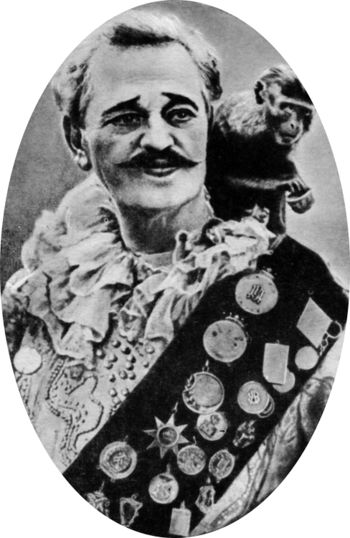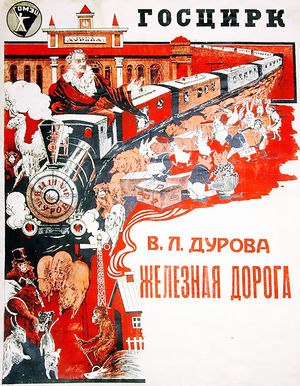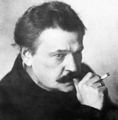Difference between revisions of "Vladimir Durov"
From Circopedia
(→Image Gallery) |
|||
| (3 intermediate revisions by the same user not shown) | |||
| Line 1: | Line 1: | ||
| − | [[File:Vladimir_Durov.jpg|right| | + | [[File:Vladimir_Durov.jpg|right|350px]] |
==Clown, Animal Trainer== | ==Clown, Animal Trainer== | ||
| Line 41: | Line 41: | ||
Each of the brothers would enter the ring with great ceremony, walking around and acknowledging the audience. They would then launch into a monologue, after which they would play up the attitudes of their animals. In Vladimir's case, this last part would take on increasing importance, to the point where Vladimir’s act would eventually center on his animal training. | Each of the brothers would enter the ring with great ceremony, walking around and acknowledging the audience. They would then launch into a monologue, after which they would play up the attitudes of their animals. In Vladimir's case, this last part would take on increasing importance, to the point where Vladimir’s act would eventually center on his animal training. | ||
| − | When, around 1884, their godfather saw the brothers perform, he suggested they resume their education. Anatoly paid no heed to the advice, but Vladimir did: he went back to school, graduated from a teachers’ college, and audited the classes of neurophysiologist I.M. Sechenov, "the father of Russian physiology," who, with I.P. Pavlov, studied animal reflexes. In 1887, he returned to the ring and made his debut as a full-fledged clown-satirist and animal trainer (with a trained wolf and a dog that could—or rather pretended to—add and subtract) at [[The Circuses of Moscow|Circus Salamonsky]], on Tsvetnoi Boulevard in Moscow, Russia’s most prestigious circus, after St. Petersburg’s [[ | + | When, around 1884, their godfather saw the brothers perform, he suggested they resume their education. Anatoly paid no heed to the advice, but Vladimir did: he went back to school, graduated from a teachers’ college, and audited the classes of neurophysiologist I.M. Sechenov, "the father of Russian physiology," who, with I.P. Pavlov, studied animal reflexes. In 1887, he returned to the ring and made his debut as a full-fledged clown-satirist and animal trainer (with a trained wolf and a dog that could—or rather pretended to—add and subtract) at [[The Circuses of Moscow|Circus Salamonsky]], on Tsvetnoi Boulevard in Moscow, Russia’s most prestigious circus, after St. Petersburg’s [[Circus Ciniselli]]. |
Vladimir, wittier and more creative than his brother, became in time the more successful of the two; his talent as an animal trainer was also a significant factor in his success. Anatoly's increased use of animals in his act was mostly an attempt to keep pace with his brother. Like Vladimir, Anatoly lectured on animal psychology, but unlike his brother, he was not taken seriously in scientific circles. | Vladimir, wittier and more creative than his brother, became in time the more successful of the two; his talent as an animal trainer was also a significant factor in his success. Anatoly's increased use of animals in his act was mostly an attempt to keep pace with his brother. Like Vladimir, Anatoly lectured on animal psychology, but unlike his brother, he was not taken seriously in scientific circles. | ||
| Line 73: | Line 73: | ||
* History: [[The Durov Dynasty]] | * History: [[The Durov Dynasty]] | ||
* Biography: [[Anatoly Durov]] | * Biography: [[Anatoly Durov]] | ||
| + | * Video: [[Durov_Documentary_Video_(c.2000)|Vladimir Durov television documentary]], Rossiya TV (c.2000) | ||
==Image Gallery== | ==Image Gallery== | ||
Latest revision as of 21:54, 10 June 2024
Clown, Animal Trainer
By Dominique Jando
In the Soviet era, Vladimir Durov was an iconic figure of the Russian circus. A street and a theater (which are still extant) were named after him. He was said to have revolutionized animal training, and he was described as a clownGeneric term for all clowns and augustes. '''Specific:''' In Europe, the elegant, whiteface character who plays the role of the straight man to the Auguste in a clown team.-satirist whose anarchistic stance against an autocratic Tsar and his government had helped bring about the Soviet revolution.
In truth, however, although Vladimir was indeed a skilled animal trainer, he used methods that were becoming prevalent in Western Europe at the same time (notably among the Hagenbecks in Germany). As for being a clownGeneric term for all clowns and augustes. '''Specific:''' In Europe, the elegant, whiteface character who plays the role of the straight man to the Auguste in a clown team.-satirist, it was his brother, Anatoly, not Vladimir, whose anti-establishment virulence got him into trouble under the Tsarist regime.
Today, the Durovs are among Russia’s most prestigious circus dynasties. From the brothers Vladimir and Anatoly Durov, the founders of the circus dynasty, to a host of Anatolys, Vladimirs, Yurys, Natalias, and Terezas, all bearing the Durov name, they have given the Russian circus an impressive number of talented clowns, animal trainers, and entertainment entrepreneurs—and a few actors too.
The Durov Family
Vladimir Leonidevich Durov was born on June 25, 1863 to a wealthy aristocratic family in Moscow. He was the fourth child and elder son of Leonid Dmitrievich Durov (1832-1867), a hereditary Lord of the Province of Moscow, who was an officer in the Moscow Police—a job he did more because he wanted to than because he had to. Vladimir’s brother, Anatoly Leonidevich (1864-1916), was born seventeen months later.
The Durov name was well known in Russia; the family had already produced a celebrity. Nadezhda Durova, remembered in Russian history as the Cavalry Girl, was Vladimir’s grandaunt. Dressed as a man, she had enrolled in a cavalry regiment to fight Napoleon’s advance in 1812. She is said to have received a medal from the hand of Field-Marshall Kutuzov, the man who had defeated Napoleon. Celebrated by Pushkin, Nadezhda eventually became a successful writer.
Vladimir Durov had three elder sisters: Margarita (1854-?); Konkordya (1860-?), among whose descendants is Lev Durov, the famous Russian actor; Liudmila (1862-?); and a younger sister, Valentina (1866-1940). Vladimir’s mother, Maria Dmitrievna Durova (1833-66), probably suffered from complications caused by Valentina’s birth: she died soon after, in 1866. Vladimir was only three years old at the time. Devastated, Vladimir’s father began to drink himself to death. He suffered from hallucinations and died a year later, in 1867.
Vladimir and Anatoly were put in the care of their godfather, Nikolai Zakharovich Zakharov, a wealthy and brilliant lawyer and occasional playwright, whose work had been produced successfully at the Maly Theater in Moscow. (He was also an inveterate gambler. He would eventually commit suicide over a gambling debt.) Zakharov sent Vladimir and Anatoly to a military academy. Likely it was at the academy that Anatoly developed his lifelong loathing for all forms of authority.
Circus Beginnings
The brothers much preferred circus acrobatics to academic studies and military exercises. This passion eventually led to their being expelled from the academy. Left to their own devices, Vladimir and Anatoly used the money their godfather had given them to hire as their teacher Angelo Briatore, an Italian acrobat from the troupe of Carl Magnus Hinné. Briatore taught them the basics of acrobatics in the old way: with much whipping. When Zakharov discovered the physical abuse, he got rid of Briatore.
Around 1878, Otto Kleist, a balagan(Russian) A fairground booth or theater. acrobat, taught Vladimir and Anatoly a trapeze act. The following year, the brothers made their performing debut in the balagan(Russian) A fairground booth or theater. of V.A. Weinstok in Tver’, a city north of Moscow. They also worked in the balagan(Russian) A fairground booth or theater. of Rinaldo, a magician, before finally joining the Robinson-Nicolet troupe—a significant step up, given that the troupe worked in circuses. They left Robinson-Nicolet in 1881 after Anatoly had an argument with his employers—the first of many arguments that would plague Anatoly’s career. It was probably because of Anatoly's temperament that the brothers separated.
After leaving Robinson-Nicolet, Vladimir found work as a groom and assistant animal trainer in Hugo Winkler’s menagerie, which had settled on Tsvetnoi Boulevard in Moscow. It was there that he learned how to work with animals, eventually becoming a capable trainer of small animals. In 1884, following in the footsteps of his brother, who had developed a successful show combining clowning with farm animals—a commonplace in the nineteenth century—Vladimir began performing as a clownGeneric term for all clowns and augustes. '''Specific:''' In Europe, the elegant, whiteface character who plays the role of the straight man to the Auguste in a clown team., using, like his brother, animals as partners.
Vladimir presented his new clown act in Petrovski Park and in the Zoological Gardens in Moscow. Being in direct competition with his sibling greatly irritated Anatoly. From the outset, Anatoly had used a pig and other animals as partners in the ring—indeed, animals would become a Durov trademark. Still, for the rest of his life, Anatoly would consider his brother a thief and competitor; the relationship between them rapidly deteriorated.
Anatoly vs. Vladimir
Vladimir's success (and Anatoly's, for that matter) as a clownGeneric term for all clowns and augustes. '''Specific:''' In Europe, the elegant, whiteface character who plays the role of the straight man to the Auguste in a clown team.-satirist came from the fact that, unlike other clowns in Russia, who were mostly Italian or French, or came from the unrefined balagans(Russian) Fairground booths or theaters., he could express himself in crisp, articulate Russian. He also had an intensely Russian sense of humor, and he could easily convey his wit in a manner other clowns couldn’t match.
Anatoly used a direct, in-your-face, occasionally insulting brand of humor. By all accounts, Vladimir was the wittier of the two brothers, and his humor was more subtle and less mordant than Anatoly’s. It was Anatoly, not Vladimir, who was responsible for the Durovs' reputation, in the Soviet era, as slayers of the old regime.
Still, Vladimir's and Anatoly's clown characters were similar in many respects. Although Vladimir obviously copied his brother at the beginning, it is difficult to know who subsequently copied whom. Both characters evolved over the years from a classic clownGeneric term for all clowns and augustes. '''Specific:''' In Europe, the elegant, whiteface character who plays the role of the straight man to the Auguste in a clown team.—one not very different, physically, from other clowns of his time—to what would eventually become the Durov image: a traditional whiteface clown costume, with sequin ornaments, a white collerette and a small shoulder cape, and practically no makeup.Each of the brothers would enter the ring with great ceremony, walking around and acknowledging the audience. They would then launch into a monologue, after which they would play up the attitudes of their animals. In Vladimir's case, this last part would take on increasing importance, to the point where Vladimir’s act would eventually center on his animal training.
When, around 1884, their godfather saw the brothers perform, he suggested they resume their education. Anatoly paid no heed to the advice, but Vladimir did: he went back to school, graduated from a teachers’ college, and audited the classes of neurophysiologist I.M. Sechenov, "the father of Russian physiology," who, with I.P. Pavlov, studied animal reflexes. In 1887, he returned to the ring and made his debut as a full-fledged clownGeneric term for all clowns and augustes. '''Specific:''' In Europe, the elegant, whiteface character who plays the role of the straight man to the Auguste in a clown team.-satirist and animal trainer (with a trained wolf and a dog that could—or rather pretended to—add and subtract) at Circus Salamonsky, on Tsvetnoi Boulevard in Moscow, Russia’s most prestigious circus, after St. Petersburg’s Circus Ciniselli.
Vladimir, wittier and more creative than his brother, became in time the more successful of the two; his talent as an animal trainer was also a significant factor in his success. Anatoly's increased use of animals in his act was mostly an attempt to keep pace with his brother. Like Vladimir, Anatoly lectured on animal psychology, but unlike his brother, he was not taken seriously in scientific circles.
In 1913, Vladimir and Anatoly performed at the same time in St. Petersburg, Vladimir at the Cirque Moderne, where he had staged Pushkin’s fables, and Anatoly at Circus Ciniselli. Vladimir got better reviews, one of which stated: “The biggest success was Vladimir’s, whose animal training was much better, and jokes were funnier.” This didn’t please Anatoly, whose response showed more spite than wit: since Vladimir was announced as "the Elder Durov," Anatoly asked to be advertised as "the Older Elder Durov."
The Soviet Years
By 1907, Vladimir Durov was presenting an "attraction(Russian) A circus act that can occupy up to the entire second half of a circus performance.," an act that could occupy the entire second half of a show. A miniature railway, replete with a train station and all sorts of railway-related props, occupied the ring. Monkeys played the engineer and the dispatcher; geese, the Red Caps; a duck, the Station Master; a goat, the train conductor; and the passengers were guinea pigs. They were prompted into their motions by an ingenious system of rewards hidden behind doors, in passenger cars, etc. Vladimir (and Anatoly as well) would later present a similar scene with rats.
Vladimir’s animal training came to dominate his professional life. In 1910, he bought a large house on Staraya Bozhedonka (today Durov Street) in Moscow to stable his animals. In 1919, it would become a center for the study of animal psychology and training, known as Durov Corner. By then, the Soviets had seized power, and Vladimir had embraced the new regime: clownGeneric term for all clowns and augustes. '''Specific:''' In Europe, the elegant, whiteface character who plays the role of the straight man to the Auguste in a clown team.-satirist he was, but he only criticized what went against Soviet ideology.Anatoly died of typhus in 1916 in Mariupol, Ukraine. Unlike Vladimir, he would never live to see the Soviet regime—which was probably just as well, since he undoubtedly would have criticized it as strongly as he had criticized the Tsarist regime, in which case the fate of the Durovs would have taken a far different course.
The Soviets seized power in 1917. By then, animal training had long since become Vladimir’s primary vocation. The new regime loudly publicized his training experiments as Soviet cultural achievements, which captivated the public’s attention. It is mostly in the domain of animal training that the Durovs' tradition would carry on—even though the traditional Durov clown attire would be passed from one generation to the next and remain an integral part of the Durovs' image for years to come.
Vladimir had married Aleksandra Ignatevna Karnaukhova, with whom he had a daughter, Zinaida, who became a writer (Zinaida Richter). A second marriage to Aleksandra’s sister, Natalia (1870-1924), produced two children, Vladimir (1888-1912) and Natalia (1889-1918), who both died in their twenties. Natalia, however, continued the Durov dynasty with her son, Yury Vladimirovich Orlov, who became Yury Durov when he was adopted by his grandfather.
A third marriage to Anna Ignatevna Karnaukhova (1878-1950), the sister of his two previous wives (obviously, what started in the Karnaukhova family stayed in the Karnaukhova family) produced another daughter, Anna. In 1933, one year before the death of her father, Anna Durova created the Moscow Animal Theater at Durov Corner, on what had become Durov Street.
Vladimir Durov died in Moscow on August 8, 1934 (he is buried at the Novodevichy Cemetery in Moscow). In time, he would be better remembered than his brother, Anatoly, partly because he had lived longer and survived well into the Soviet era, partly because he had spent most of his career in Moscow, unlike his brother, who had lived in Voronezh, farther from the public eye. He also published a children book, Grandpa Durov's Animals (1925), which is still in print today under the revised title, My Animals.
Vladimir Durov was, like his brother, a well-educated man. He had developed a genuine interest in physiology and animal behavior. Among the many weird things done by Soviet officials during their seven decades in power, Russian scientists kept Vladimir’s brain in the Brain Institute in Moscow, presumably for some future study on the behavior of clowns and animal trainers...
Suggested Reading
- В.Л. Дуров, Мои Звери (Moscow, Makhaon, 2013 — Originally published as Звери Дедушки Дурова, Leningrad, Государственное Издательство, 1925) — ISBN 5389059786
See Also
- History: The Durov Dynasty
- Biography: Anatoly Durov
- Video: Vladimir Durov television documentary, Rossiya TV (c.2000)
















